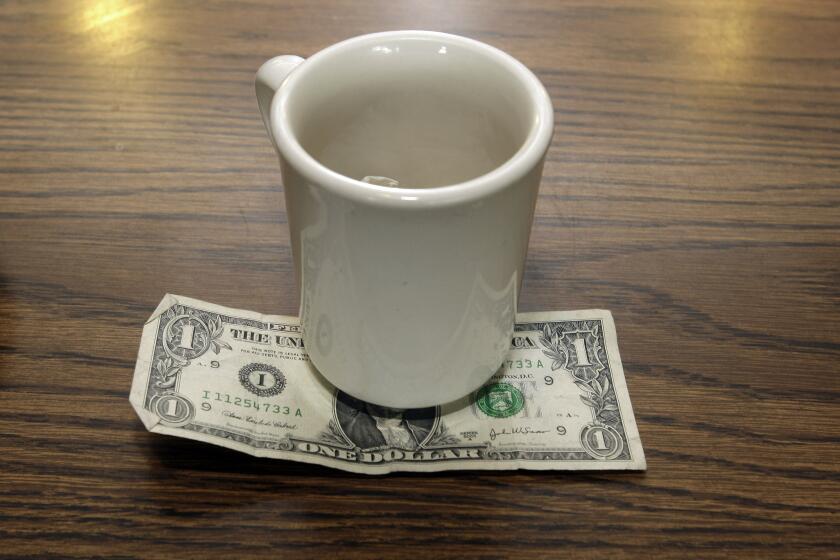Training for Careers in Cuisine : Cooking Schools: The Old and the New Guard
- Share via
NEW YORK — After one of your home-cooked meals--sauteed veal with porcini, perhaps, or herb-rich Basque piperade--do your guests say you should open a restaurant?
It’s not the worst idea you’ll ever hear, but it may well involve the most work.
These days, a career in cuisine can be more glamorous than ever and most assuredly more lucrative. In less than a decade, chefs in America have risen from mere hired hands to media superstars, with successful ones pulling down annual salaries in excess of $100,000.
Yet the road to a job as a chef, caterer or restaurateur is long and arduous, beset with far too many options to allow a mindless passage.
“We want them to know it’s a tough business,” said Donna Linden of the Culinary Institute of America in Hyde Park, N.Y. “They’re going to be working while others are playing. You don’t come here to find out if you want to be a chef. You come here only if you want to be a chef.”
Known as the CIA
The institute, known as the CIA among its graduates, is the oldest and best known of U.S. cooking schools. Forty years after it was founded to train returning World War II veterans, it turns out class after class of kitchen professionals, many bent on personally interpreting New American Cuisine.
The CIA offers 1,850 full-time students a 21-month associate degree program in cooking, baking or hospitality management while serving up short courses to as many as 2,000 professionals expanding their horizons.
However, few colleges can beat the curriculum put together by Johnson and Wales in Providence, R.I. The 71-year-old institution showcases the nation’s largest program in culinary arts, boasting 3,000 students from 44 states and 27 countries.
“The industry has discovered us as a resource,” said college president Morris Gaebe. “We have over 10,000 graduates working, and we find them everywhere we travel.”
Students at Johnson and Wales spend at least two trimesters each year attending laboratory classes in the college’s 29 kitchens, moving quickly from basic culinary skills to the finer points of garde-manger, classical and international cuisine. As they advance, fledgling chefs get a chance to work at two inns owned and operated by Johnson and Wales.
Quality Varies Widely
Across the country, various trade schools may offer their own culinary apprenticeship program. The quality of this instruction varies widely, so be sure to assess it in terms of your specific interests.
At their best, trade school programs can rival the centuries-old food apprenticeships of Europe.
The type of school chosen for culinary training is a reflection of the future chef’s particular ambitions. Institutions like the CIA in the United States, Tante Marie in England and Cordon Bleu in Paris have become so respected that they seem too staid for some advocates of the new cuisine.
They also strike many as too serious (and too long-term) for casual forays into refinement of home technique.
Not surprisingly, there is a whole new breed of cooking school perfectly suited for “foodies,” who in this case include people drawn to cooking by their love of eating.
Paul Levy, author of “The Official Foodie Handbook,” said this particular type of culinary animal would rather be spotted at a fast-food outlet than at one of these old-fashioned institutions.
“The proof of the pudding is in the eating,” Levy said. “You will find, when applying for a job, that foodie restaurateurs do prefer graduates of foodie schools.”
The ultimate foodie school has to be Ecole de Cuisine La Varenne in Paris, founded by women from England and America but taught in French. La Varenne offers a high-priced 36-week diploma program, along with a variety of short courses.
Two First-Rate Programs
When in France, the prospective cuisinier might also take part in short courses taught at the Marie-Blanche de Broglie Cooking School, Ecole Lenotre, Paris en Cuisine, Madeleine Kamman or La Grande Carte d’Acquitaine.
England offers two first-rate comprehensive programs, at La Petit Cuisine in Surrey and at Leith’s School of Food and Wine in London.
Americans who find the CIA or Johnson and Wales a bit too stodgy can try the New School in New York and the California Culinary Academy in San Francisco. New York’s A la Bonne Cocotte is one of the best places to look for short courses.
Two other resources might come in handy for the would-be restaurateur.
Culinary Arts News keeps track of opportunities and is available from P.O. Box 153, Western Spring, Ill. 60558. A group called CAREF assesses training programs and even offers a few scholarships. Write to CAREF at 1001 Connecticut Ave. NW, Suite 800, Washington, D.C. 20036.
More to Read
Eat your way across L.A.
Get our weekly Tasting Notes newsletter for reviews, news and more.
You may occasionally receive promotional content from the Los Angeles Times.










